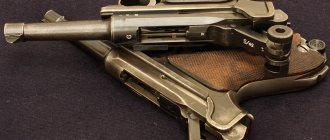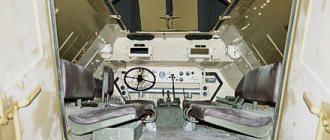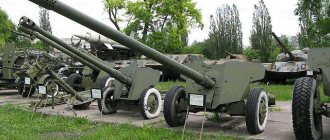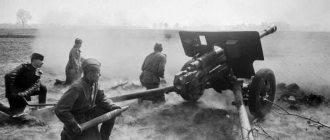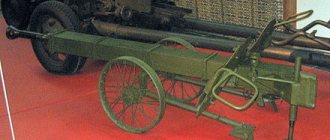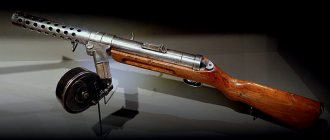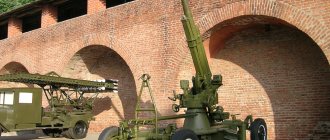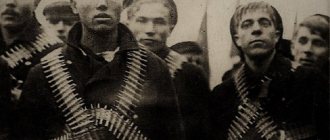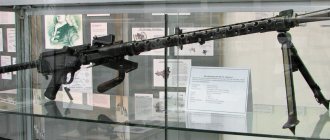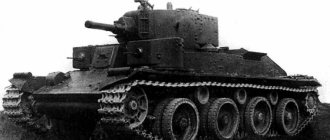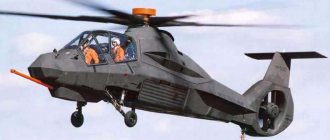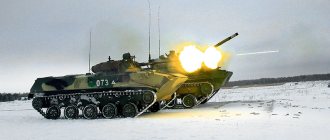- Watervliet Arsenal[en] US Army (barrel production and fluting);[5]
First line contractors (private sector)
- Hudson Motor Car Company (33,201 naval mounts; peak production 2,330 guns per month, September 1943);[6]
- General Motors Corporation, Pontiac Motor Division;[7][8]
- Westinghouse Electric Manufacturing Company.[9]
was several times ahead of the production plan for the production of guns[10]. A combined arms school for training technical specialists in the operation and maintenance of anti-aircraft artillery of the Oerlikon and Bofors types was organized.[11] In addition, Pontiac engineers made a number of minor design changes at the request of military personnel, in particular, the shoulder rest was redesigned for better recoil absorption, as well as the rear sight post for aiming with the left eye[12].
Great Britain
Counterfeit production of a gun of a similar design was established by British smuggler Dennis Kendall[en] at a plant in Grantham, Lincolnshire, to equip fighter aircraft of the Royal Air Force of Great Britain[13].
Between two world wars
By 1927, she developed and put on the conveyor a model called Oerlikon S
(three years later became simply
1S
). Created for a more powerful cartridge 20x110 mm and was characterized by a higher initial projectile speed of 830 m/s, which was accompanied by an increase in the mass of the structure and a decrease in the rate of fire to 280 rounds per minute. Thus, gunsmiths responded to the rapidly changing demands of the new time, which required from this type of weapon, first of all, an increase in the initial velocity of the projectile, which significantly increased armor penetration and turned the Oerlikons not only into an aviation, but also an anti-tank model of a small-caliber gun. In fact, the new Oerlikon successfully hit almost all types of tanks contemporary to it at that time, not to mention wedges.
In 1935, the Swiss took another qualitative step in the development of air cannons. New type of cannon "Flügelfest"
- (
flügelfest
- “wing” modification of the gun) received three options under the designations “FF”, “FFL” and “FFS”.
Improvements in the guns included a reduction in the mass of the product, an increase in the rate of fire and the initial velocity of the projectile. However, reloading in the air still remained a difficult obstacle to overcome, so the ammunition load was increased by directly increasing the magazine capacity. Options were produced for 45, 60, 75 and 100 rounds, of which the 60-round version became the most popular.
In the 1930s, a number of companies from different countries acquired licenses for new Oerlikons. The French "Hispano-Suiza" began producing its modification "FFS". Germany developed the Oerlikon FF into a very successful model of the MG FF air cannon. The Japanese Imperial Navy adopted the Oerlikons Type 99-1 and 99-2, which were a development of the FF and FFS models.
Background
During the First World War, the German engineer Reinhold Becker developed an automatic 20 mm caliber cannon, the automation of which was based on a free shutter and advanced ignition of the capsule [1]. The gun used a 20×70 mm cartridge, the rate of fire reached 300 rounds per minute. The new gun was used as an aviation and anti-aircraft modification, but the new gun did not have time to significantly influence the course of hostilities, since the war was already ending.
In compliance with the prohibitions on the development of weapons in Germany imposed by the Treaty of Versailles, patents for the invention, along with design work, moved to the Swiss company SEMAG
(Template:lang-de), located near Zurich.
SEMAG
improved the Becker gun and in 1924 released a version chambered for a more powerful 20x100 mm cartridge with a slightly increased rate of fire, now reaching 350 rounds per minute.
The Second World War
Oerlikon launched a qualitatively improved FFS series in 1938 (Oerlikon-SS). This model and especially its variants from the Second World War period (1SS - 1942, 2SS - 1945) produced a rate of fire of up to 650 rounds per minute. This model was widely used on ships of the American and British navies as an anti-aircraft gun. Also, a modified version was mounted in an open rotating turret on a low-speed anti-submarine aircraft - a “submarine hunter”, as its main small arms and cannon armament[14].
During the Second World War, the low effectiveness of anti-aircraft guns of 20 - 25 mm caliber was revealed. The destructive effect of a small-caliber projectile was too insignificant to shoot down an attacking aircraft, and the rate of fire of machine guns of that time did not provide the required density of fire. The firing range made it possible to fire at aircraft only at close range, often after the aircraft had already used their weapons. Already in 1943, a single anti-aircraft gun was recognized as an insufficiently effective means of air defense [15]. Therefore, for example, Oerlikons were increasingly used in paired configurations.
37-mm gun 61-K model 1939. USSR
Let's continue the Bofors theme. The Soviet 37-mm gun of the 1939 model was developed using the technical base of the Swedish ZAP Bosfors L60. The gun was created by decision of the GAU Red Army by designer M.N. Loginov. During the Great Patriotic War, this weapon was the main one in the air defense system. In addition, especially in the first period of the war, the 61-K was often used as an effective anti-tank weapon.
The 37-mm ZAP 61-K is a single-barreled, fully automatic small-caliber gun. All processes are automated in the same way as the basic model. Only the feeding of cartridges into the magazine, aiming and pointing of the gun was carried out manually. Automation works due to the movement of the barrel.
The gun was transported using a truck or any other tractor at a speed of up to 60 km/h. Calculation 7 people. A total of 22,600 guns were produced.
The gun went through the entire war with honor and ended it with participation in the victory salute in Berlin. Soviet anti-aircraft gunners treated this weapon with great respect. And the combat path of the 61K gun continued for a long time in the post-war period.
Advantages of the gun: 1. High rate of fire. 2. Good ceiling. 3. Ease of use.
Disadvantages: 1. Lack of a contactless fuse on the projectile.
Afghan war
During the Afghan war, the use of Oerlikons by detachments of the Afghan Mujahideen was noted. The first deliveries of Oerlikons were recorded in January 1985[16]. On July 12, 1987, a special forces group of the 186th separate special forces detachment of the 22nd Regiment Regiment, under the command of Senior Lieutenant Oleg Onishchuk, destroyed a caravan in which, in addition to several dozen small arms, several mortars, grenade launchers and a lot of ammunition, 20mm was captured from the enemy Oerlikon automatic anti-aircraft gun, fully equipped and with accompanying documentation. For this, Onischuk was awarded the Order of the Red Banner[17].
Development
However, in the same year, SEMAG
went broke.
, named after its location - Template:iwTemplate:ref-en, acquired the rights to develop the gun, production facilities and received a team of skilled workers who had worked at SEMAG until that time
. The designer of the new modification was the Austrian engineer, former military pilot, inventor and innovator Antoine Gazda[2]. At the same time, Gazda acted as an intermediary between the British side and the Americans regarding the organization of mass production of guns in the USA for the British Empire[3].
In the USA, having paid license fees, they actually developed their own modification, significantly simplified in comparison with the Swiss model Template:no AI (like any other models of American weapons and military equipment created under license based on foreign models) in order to simplify its maintenance and operation , as well as speeding up production, since the technologically simpler American modifications were much easier not only in everyday use, but also in production. Tests of a trial batch of Oerlikons, purchased for evaluation purposes Template:np5 of the US Army, took place at the Aberdeen Proving Ground (23-mm Danish Template:np5, 20-mm German "Rheinmetall" and 20-mm French "Hispano-Suiza" were also tested there ", - samples of "Oerlikon" and "Hispano-Suiza" were borrowed for temporary use from the Main Directorate of Fleet Armaments).[4]
Notes
- ↑ 1234
[commi.narod.ru/txt/shirad/113.htm 20-mm guns from Oerlikon] - [books.google.ru/books?id=qN8DAAAAMBAJ&pg=PA87#v=onepage&q&f=false Jet Propelled Helicopter Has Only One Rotor. (English)] // Popular Mechanics
, April 1945, v. 83, no. 4, p. 87. - Pawle, The Wheezers & Dodgers, 2009, p. 63.
- [babel.hathitrust.org/cgi/pt?id=mdp.39015025142053;view=1up;seq=5 The Ordnance Department: Planning Munitions for War. (English)], 1955, p. 433
- Thomson & Mayo, The Ordnance Department, 1960, p. 77-79.
- Hyde, Arsenal of Democracy, 2013, p. 162-164.
- Hyde, Arsenal of Democracy, 2013, p. 162.
- Hyde, Arsenal of Democracy, 2013, p. 165-166.
- Hyde, Arsenal of Democracy, 2013, p. 164.
- [books.google.ru/books?id=xNYDAAAAMBAJ&pg=PA169#v=onepage&q&f=false Modern Miracle. (English)] // Popular Mechanics
, September 1942, v. 78, no. 3, p. 169. - [books.google.ru/books?id=TtYDAAAAMBAJ&pg=PA168#v=onepage&q&f=false Our New Schools of War. (English)] // Popular Mechanics
, April 1943, v. 79, no. 4, p. 168. - [books.google.ru/books?id=H9cDAAAAMBAJ&pg=PA88#v=onepage&q&f=false Left-Eyed Gunner's Sight Built for Ack-Ack Gun. (English)] // Popular Mechanics
, August 1943, v. 80, no. 2, p. 88. - Pawle, The Wheezers & Dodgers, 2009, p. 73.
- [books.google.ru/books?id=xdYDAAAAMBAJ&pg=PA7#v=onepage&q&f=false “Noiseless” Sea Skimmer to Battle Submarines. (English)] // Popular Mechanics
, February 1943, v. 79, no. 2, p.7. - Platonov A.V.
Air defense of naval forces 1941-1945. - St. Petersburg: Gangut, 2010. - P. 29, 36. - ISBN 978-5-904180-15-7. - [w[www.docme.ru/doc/1082378/boevye-dejstviya-na-pandzhshere “Afghanistan: fighting in Panjshir. OG “Anava”]— Ryazan: “Ryazan region. printing house", 2014. - pp. 174-175. — 600 s. — ISBN 978-5-93165-295-5.
- GRU special forces. Volume 3. Afghanistan - the finest hour of special forces. 1979-1989 - M.: NPID "Russian Panorama", 2013. - P. 491-493. — 736 p. — ISBN 978-5-93165-324-2.
Production
Template: significance of the section The following companies, in addition to the developer company, were involved in licensed (with the payment of royalties due to the patent holder - the company Werkzug Mashinenfabrik Oerlikon) and unlicensed production of 20-mm Oerlikon cannons:
USA
First Line Contractors (Public Sector)
Template:Columns Template:Column
- Template:np5 US Army (production and corrugation of barrels);[5[5]li>
First line contractors (private sector)
- Hudson Motor Car Company (33,201 naval mounts; peak production 2,330 guns per month, September 1943);[6[6]li>
- General Motors Corporation, Pontiac Motor Division;[7[7][8]li>
- Westinghouse Electric Manufacturing Company.[9[9]li>
was several times ahead of the production plan for the production of guns. a number of minor design changes at the request of military personnel, in particular, the shoulder rest has been redesigned for better recoil absorption, as well as the rear sight post for aiming with the left eye[1[12]/p>
Great Britain
Counterfeit production of a gun of a similar design was established by a British smuggler Template:np5 at a plant in Grantham, Lincolnshire Template:no AI, to equip fighters of the Royal Air Force of Great Britain[1[13]/p>
Literature
- Hyde, Charles K.
[b[books.google.ru/books?id=P-PCAgAAQBAJ&printsec=frontcover&hl=ru#v=onepage&q&f=false Arsenal of Democracy: The American Automobile Industry in World War II. (English)] Detroit, Mich.: Wayne State University Press, 2013. - 264 p. - (Great Lakes Books) - ISBN 978-0-8143-3951-0. - Murray, James V., Swantek, John. [b[babel.hathitrust.org/cgi/pt?id=uiug.30112101040449;view=1up;seq=1 The Watervliet Arsenal: A Chronology of the Nation's Oldest Arsenal (1813-1993). (English)] Watervliet, NY: Watervliet Arsenal, Public Affairs Office, 1993. - 489 p.
- Paule, Garald
. [b[books.google.ru/books?id=6wiSAwAAQBAJ&printsec=frontcover&hl=ru#v=onepage&q&f=false The Wheezers & Dodgers: The Inside Story of Clandestine Weapon Development in World War II. (English)] Barnsley: Pen & Sword Books, 2009. - 304 p. — ISBN 978-1-84832-026-0.
Mass and speed
Let's leave cumulative ammunition aside - we talked about them in previous issues of PM.
The armor penetration of classic, kinetic projectiles depends on three factors - impact force, material and shape of the projectile. The impact force can be increased by increasing the mass of the projectile or its speed. An increase in mass while maintaining the caliber is permissible within very small limits; the speed can be increased by increasing the mass of the propellant charge and increasing the length of the barrel. Literally in the first months of the war, the walls of the anti-tank gun barrels thickened, and the barrels themselves lengthened. A simple increase in caliber was also not a panacea. Powerful anti-tank guns at the beginning of World War II were made basically this way: they took the swinging parts of anti-aircraft guns and placed them on heavy carriages. Thus, in the USSR, on the basis of the swinging part of the B-34 naval anti-aircraft gun, a 100-mm BS-3 anti-tank gun with a warhead weight of 3.65 tons was created. (For comparison: the German 3.7-cm anti-tank gun weighed 480 kg). We were even embarrassed to call the BS-3 an anti-tank gun and called it a field gun; before that there were no field guns in the Red Army, this is a pre-revolutionary term.
4.2/2.8 cm armor-piercing tracer sub-caliber projectile mod. 41
The Germans, based on the 8.8-cm anti-aircraft gun "41", created two types of anti-tank guns weighing 4.4-5 tons. Based on the 12.8-cm anti-aircraft gun, several samples of anti-tank guns were created with a completely prohibitive weight of 8.3-12 ,2 tons. They required powerful tractors, and camouflage was difficult due to their large dimensions.
These guns were extremely expensive and were produced not in thousands, but in hundreds, both in Germany and in the USSR. Thus, by May 1, 1945, the Red Army had 403 units of 100-mm BS-3 cannons: 58 in the corps artillery, 111 in the army artillery and 234 in the RVGK. But the divisional artillery did not have them at all.
Conical nozzles
It is curious that the conical barrel was used not only in anti-tank guns, but also in anti-aircraft artillery and special-power artillery.
Thus, for the 24-cm long-range K.3 cannon, mass-produced with a conventional barrel, in 1942-1945 several more samples of conical barrels were created, on the creation of which they worked together. For firing from a conical barrel, a special 24/21 cm sub-caliber projectile weighing 126.5 kg, loaded with 15 kg of explosive, was created.
The survivability of the first conical barrel turned out to be low, and changing barrels after several dozen shots was too expensive. Therefore, it was decided to replace the conical barrel with a cylindrical-conical one. They took a standard cylindrical barrel with fine rifling and equipped it with a conical nozzle weighing one ton, which was simply screwed onto the standard gun barrel.
During the firing, the survivability of the conical nozzle turned out to be about 150 shots, that is, higher than that of the Soviet 180-mm B-1 naval guns (with fine rifling). During firing in July 1944, an initial speed of 1130 m/s and a range of 50 km were obtained. During further tests, it also became clear that projectiles that initially passed through such a cylindrical part were more stable in flight. These guns, along with their creators, were captured by Soviet troops in May 1945. The K.3 system with a cylindrical-conical barrel was refined in 1945-1946 in the city of Semmerda (Thuringia) by a group of German designers led by Assmann.
Light 20-mm anti-aircraft gun GAI-D01 from the Oerlikon concern - Military site Best Army
20-mm coaxial light anti-aircraft gun GAI-D01 in firing position. Each 20-mm gun contains a box with 120 rounds of ready-to-use ammunition. The gunner uses an Italian Galileo P56 sight and a sighting device with an analog computer.
Better known as a product (today part of the Rheinmetall concern), the GAI D01 20mm Oerlikon gun base was designed in the early 1970s, designated Hispano-Suiza HSS 666A, and was ready for delivery in 1978. The equipment successfully crossed the chasm between single-barrel 20mm weapons with short range and comparatively low firepower and heavy equipment such as coaxial 35mm. GDF-002 system with a large range and high firepower. The combat unit is based on a two-wheeled carriage weighing 470 kg. and is equipped with an adjustable eye for a towing unit, it is brought into combat condition by a crew of 5 people within one minute from the moment of stopping.
Wankel engine
Although the gun was initially conceived as an anti-aircraft gun, it is also capable of fulfilling the role of a ground weapon. The two guns are a KAD-B pneumatic gun (originally HS 820-SL) each weighing 68 kg, the KAD B16 cannon is located on the left (with left-hand feed on the conveyor belt), and the KADB17 cannon is located on the right (with right-hand feed). Ammunition is supplied from a magazine with 120 shells with a total mass of 68 kg. The gunner can use different firing modes, including firing single shells, burst, salvo or continuous fire. The base is controlled by hydraulics (for emergency situations there is manual control). The power source is 6 ,9 hp, NSU "Wackel" rotary engine, which is located under the gunner's adjustable seat. In power mode, the horizontal guidance speed is 80° per second, and the vertical guidance speed is 48° per second. The gunner uses the Galileo P56 sight. This is a system of Italian origin and can only be used in good weather conditions. It is created on the basis of a semiconductor analog computer, has a monocular optical sight with 5x magnification, an objective prism with movement from -7 to +85 ° and a control panel into which the gunner manually enters the coordinates of the target. When using the weapon in the “ground” mode -air "gunner must first detect the target visually. He can receive information by radio, from a target acquisition system, for example, an Italian radar system such as the LPD-20. He then enters the set values \u200b\u200binto the computer: target speed in the range between 216 and 1260 km/h and Intersection distance in the range between 100 and 1000 m. Intersection distance is the distance at which the sight line intersects the target's line of movement at a right angle. The gunner then begins to pursue the target using the iron sight, then switches to the optical sight and leads the target until the aim point coincides with the target. Next, the gunner releases the helm away from himself, thereby allowing the computer to begin adjusting the horizontal and vertical guidance angles. If the gunner keeps his sight in the center of the target, he is guaranteed to have a chance of hitting.
Ground targets
To hit ground targets, the gunner enters a flight range value in the range from 100 to 2500 m. Five types of projectiles are used (AR-T.HEI, HEI-T, SAPHEI and SAPHEI-T), each weighing up to 0.34 kg, as well as training ones. Now production has ceased in Switzerland, although it is expected to continue in Turkey, where MKEK produces weapons for the Turkish army. The GAI-D01 is in service with several countries, including Bolivia and Guatemala.
This is the twin 20mm light anti-aircraft gun GAI-D01 in firing position, showing the Wankel engine located under the gunner's seat. This system only operates in good weather conditions, although it can be equipped with the Contraverse LDP-20 radar.
Characteristics of GAI-D01
Caliber: 20 mm Weight: in stowed position with ammunition 1800 kg; in combat position 1330 kg; Dimensions: length in stowed position 4.59 m; width 1.86 m; height 2.34 m; Vertical guidance angle: -3.+81 Horizontal guidance angle: 360′ Initial projectile speed: 1100 - 1150 m/s; Maximum horizontal range: 5700 m; Working horizontal: 2200 m; Maximum vertical range: 4500 m ;Working vertical: 1500 m; Cyclic rate of fire: 1000 rounds per minute from each barrel Crew: 5 people (one on the carriage)
